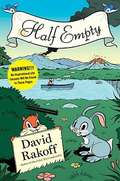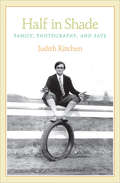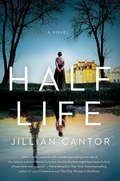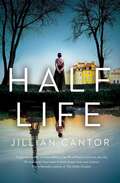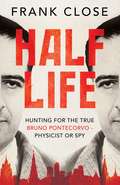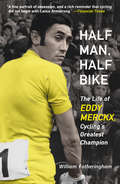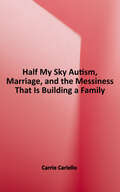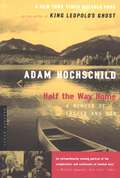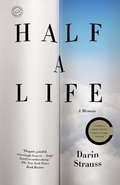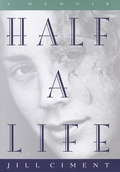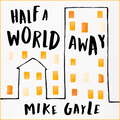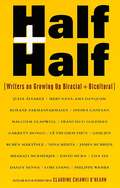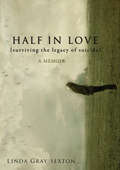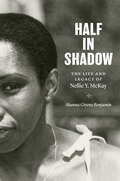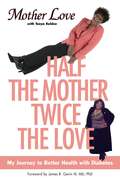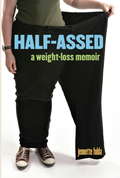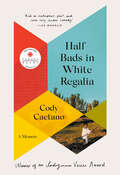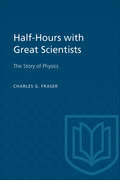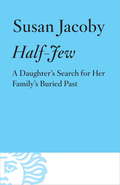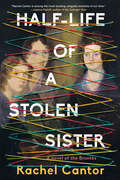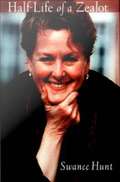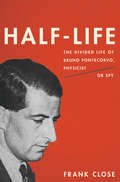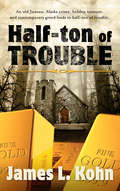- Table View
- List View
Half Empty
by David RakoffThe inimitably witty David Rakoff, New York Times bestselling author of Don't Get Too Comfortable, defends the commonsensical notion that you should always assume the worst, because you'll never be disappointed. In this deeply funny (and, no kidding, wise and poignant) book, Rakoff examines the realities of our sunny; gushy; everyone-can-be-a-star contemporary culture and finds that, pretty much as a universal rule, the best is not yet to come, adversity will triumph, justice will not be served, and your dreams won't come true. The book ranges from the personal to the universal, combining stories from Rakoff's reporting and accounts of his own experiences: the moment when being a tiny child no longer meant adults found him charming but instead meant other children found him a fun target; the perfect late evening in Manhattan when he was young and the city seemed to brim with such possibility that the street shimmered in the moonlight - as he drew closer he realized the streets actually flickered with rats in a feeding frenzy. He also weaves in his usual brand Oscar Wilde-worthy cultural criticism (the tragedy of Hollywood's Walk of Fame, for instance). Whether he's lacerating the musical Rent for its cutesy depiction of AIDS or dealing with personal tragedy, his sharp observations and humorist's flair for the absurd will have you positively reveling in the power of negativity. From the Hardcover edition.
Half In Shade: Family, Photography, and Fate
by Judith Kitchen"Judith Kitchen has written a book that is at once clear and accessible and at the same time insistently complex. Her effortlessly constructed hybrids make Half in Shade part memoir, part speculation, part essay, a demonstration of the interactive art of seeing, and finally for me, a beautifully sustained meditation. It is at that meditative level that the book's potent, unsentimental emotive power gathers."--Stuart DybekWhen Judith Kitchen discovered boxes of family photos in her mother's closet, it sparked curiosity and speculation. Piecing together her memories with the physical evidence in the photos, Kitchen explores the gray areas between the present and the past, family and self, certainty and uncertainty. The result is a lyrical, ennobling anatomy of a heritage, family, mother-daughter relationships, and the recovery from an illness that captures with precision the forces of the heart and mind when "none of us knows what lies beyond the moment, outside the frame."Judith Kitchen is the award-winning author of several works of fiction, nonfiction, and poetry. Her work has won the Lillian Fairchild Award, a Pushcart Prize, and the S. Mariella Gable Fiction Prize. She has served as judge for the AWP Nonfiction Award, the Pushcart Prize in poetry, the Oregon Book Award, and the Bush Foundation fellowships, among others. The recipient of a National Endowment for the Arts fellowship, Kitchen lives in Port Townsend, Washington, and serves on the faculty and as codirector of the Rainier Writing Workshop at Pacific Lutheran University.
Half Life: A Novel
by Jillian CantorThe USA Today bestselling author of In Another Time reimagines the pioneering, passionate life of Marie Curie using a parallel structure to create two alternative timelines, one that mirrors her real life, one that explores the consequences for Marie and for science if she’d made a different choice. In Poland in 1891, Marie Curie (then Marya Sklodowska) was engaged to a budding mathematician, Kazimierz Zorawski. But when his mother insisted she was too poor and not good enough, he broke off the engagement. A heartbroken Marya left Poland for Paris, where she would attend the Sorbonne to study chemistry and physics. Eventually Marie Curie would go on to change the course of science forever and be the first woman to win a Nobel Prize.But what if she had made a different choice? What if she had stayed in Poland, married Kazimierz at the age of twenty-four, and never attended the Sorbonne or discovered radium? What if she had chosen a life of domesticity with a constant hunger for knowledge in Russian Poland where education for women was restricted, instead of studying science in Paris and meeting Pierre Curie?Entwining Marie Curie’s real story with Marya Zorawska’s fictional one, Half Life explores loves lost and destinies unfulfilled—and probes issues of loyalty and identity, gender and class, motherhood and sisterhood, fame and anonymity, scholarship and knowledge. Through parallel contrasting versions of Marya’s life, Jillian Cantor’s unique historical novel asks what would have happened if a great scientific mind was denied opportunity and access to education. It examines how the lives of one remarkable woman and the people she loved – as well as the world at large and course of science and history—might have been irrevocably changed in ways both great and small.
Half Life: A Novel
by Jillian CantorA brilliant sliding-doors reimagining of the passionate life of the first woman to win a Nobel Prize – and the life Marie Curie might have led if she had chosen love over science. Poland, 1891. Marie Curie (then Marya Sklodowska) was engaged to a budding mathematician, Kazimierz Zorawski. But when his mother insisted Marya was not good enough, he broke off the engagement. A heartbroken Marya left Poland for Paris to study chemistry and physics at the Sorbonne. Marie would go on to change the course of science forever and become the first woman to win a Nobel Prize. But what if Marie had made a different choice? What if she had stayed in Poland, married Kazimierz, and never attended the Sorbonne or discovered radium? What if Marie had chosen her first love and a life of domesticity, still ravenous for knowledge in Russian Poland where education for women was restricted, instead of studying science in Paris and meeting Pierre Curie? Seamlessly entwining the lives of Marya and Marie, Half Life is a powerful story of love and friendship, motherhood and sisterhood, fame and anonymity – and a woman destined to change the world.
Half Life: The Divided Life of Bruno Pontecorvo, Physicist or Spy
by Frank CloseThe memo landed on Kim Philby's desk in Washington, DC, in July 1950. Three months later, Bruno Pontecorvo, a physicist at Harwell, Britain's atomic energy lab, disappeared without a trace. When he re-surfaced six years later, he was on the other side of the Iron Curtain.One of the most brilliant scientists of his generation, Pontecorvo seemed to have been privy to many secrets: he had worked on the Anglo-Canadian arm of the Manhattan Project, and quietly discovered a way to find the uranium coveted by nuclear powers. Yet when he disappeared MI5 insisted he was not a threat. Now, based on unprecedented access to archives, letters and surviving family members and scientists, award-winning writer and physics professor Frank Close pieces together an answer to whether Pontecorvo's defection ended a life of spycraft - and exposes a life irrevocably marked by the advent of the atomic age and the Cold War.
Half Man, Half Bike: The Life of Eddy Merckx, Cycling's Greatest Champion
by William FotheringhamLeading cycling writer William Fotheringham presents the biography of the greatest cyclist in history, Eddy Merckx--the extraordinary man who is to cycling what Muhammad Ali is to boxing. This definitive history chronicles his life, examining both the ups and the downs. Throughout his professional career Merckx amassed an astonishing 445 victories and exhibited a remorseless sense of domination that created his legend. But his triumphs only tell half of a story that includes horrific injury, a doping controversy, and tragedy. To discover the background of the Belgian cyclist's former invincibility, the author spoke with those who were there at the time and those who knew Merckx best. This is the singular tale of a man whose fear of failure would drive him to reach the highest pinnacles before ultimately destroying himself.
Half My Sky: Autism, Marriage, and the Messiness That Is Building a Family
by Carrie CarielloFive kids. Autism. Marriage. Building a family is a messy business. In her most revealing memoir yet, Carrie is candid about the challenges of marriage, motherhood, and keeping one's identity in the midst of raising a family. She gives the reader a glimpse into life with a diagnosed child. She shares their experience with puberty, social media, high school, and steps toward independent living. Composed as a series of powerful letters, her writing is gritty yet tender. In prose that is nearly poetic, Carrie makes you feel as though you are old friends, sitting down for a cup of coffee and a heartfelt conversation. She chronicles the journey to find a post-high school opportunity for her son Jack and gives an honest account about the conflict when it comes to letting him go. She explains how, in this autism life, there is no manual. There are no instructions for how to untether yourself from a tender child who needed you for so long, you forgot what life was like before he disrupted your world in an exquisitely magical way. Her story will resonate with anyone preparing to transition a child after high school and beyond. Again and again, Carrie reminds us of a single truth. We are not alone. You are not alone.
Half The Way Home: A Memoir of Father and Son
by Adam HochschildFrom the author of the best-selling King Leopold's Ghost, this haunting and deeply honest memoir tells of Adam Hochschild's conflicted relationship with his father, the head of a multinational mining corporation. The author lyrically evokes his privileged childhood on an Adirondack estate, a colorful uncle who was a pioneer aviator and fighter ace, and his first explorations of the larger world he encountered as he came of age in the tumultuous 1960s. But above all this is a story of a father and his only son and of the unexpected peace finally made between them.
Half a Life
by Darin StraussIn this powerful, unforgettable memoir, acclaimed novelist Darin Strauss examines the far-reaching consequences of the tragic moment that has shadowed his whole life. In his last month of high school, he was behind the wheel of his dad's Oldsmobile, driving with friends, heading off to play mini-golf. Then: a classmate swerved in front of his car. The collision resulted in her death. With piercing insight and stark prose, Darin Strauss leads us on a deeply personal, immediate, and emotional journey--graduating high school, going away to college, starting his writing career, falling in love with his future wife, becoming a father. Along the way, he takes a hard look at loss and guilt, maturity and accountability, hope and, at last, acceptance. The result is a staggering, uplifting tour de force.Look for special features inside, including an interview with Colum McCann.Join the Circle for author chats and more.RandomHouseReadersCircle.comFrom the Trade Paperback edition.
Half a Life
by Jill CimentJill Ciment weaves an unforgettable tale of survival, compassion, and courage, in this haunting recollection of a child surrounded by confusion and madness, and her struggle to find an identity. Half a Life traces Jill Ciment's family from Toronto to the California desert - -a landscape and culture so alien to her father that the last vestiges of sanity leave him. As madness engulfs him he becomes increasingly brutal and the family, grasping at survival, throws him out the door. Having no understanding that he has done anything wrong, he first lives in his car at the end of the driveway, waiting to be invited back in, before exiting completely from their lives.Poor and fatherless, Ciment spends the years from age fourteen to seventeen, as a gang girl, a professional forger, a stripper, a corporate spy, and finally, a high school dropout who by age eighteen has seduced her art teacher, a man nearly three decades her senior and bluffed her way into college in an effort to shape a future. Ciment is cutting, insightful and clearly unapologetic as she details the confusion and bravado of a child heroine whose dreams and tenacity allow her finally, to create the life she has been so desperately seeking.
Half a World Away: The heart-warming, heart-breaking Richard and Judy Book Club selection
by Mike Gayle'His most accomplished and moving novel yet' Lisa Jewell'Emotionally high-voltage' MetroFrom the author of The Man I Think I Know***Strangers living worlds apart.Strangers with nothing in common.But it wasn't always that way...Kerry Hayes is a single mum, living on a tough south London estate. She provides for her son by cleaning houses she could never hope to afford. Taken into care as a child, Kerry cannot ever forget her past.Noah Martineau is a successful barrister with a beautiful wife, daughter and home in fashionable Primrose Hill. Adopted as a child, Noah always looks forward, never back.When Kerry reaches out to the sibling she lost on the day they were torn apart as children, she sets in motion a chain of events that will have life-changing consequences for them both. By turns funny and moving, Half a World Away is a story that will stay with you long after you read its powerfully emotional, heartbreaking final page.***Readers love Half a World Away!'These are people who matter, situations one can believe. Most readers will find themselves caring very much. A life-affirming read.' Vine'It isn't easy, it is heart-wrenching, but, oh, is it worth reading. I can't recommend this book highly enough.' Vine 'How have I not read a Mike Gayle book before? I want to give this book all of the starts in the universe. I cried my eyes out at the end. It is touching, heart-wrenching and thought-provoking.' Netgalley'This story is raw and beautiful and sad. It puts lots of things into perspective and makes you think about what is important in life. Beautifully written, easy to read and will certainly bring tears to your eyes. A must read.' Netgalley 'This is a beautiful, beautiful book. It's about family, about class, about love, about choices and sacrifice. It's about letting go and learning to hold on. It's optimistic and heartbreaking and funny and emotional. It's the kind of book that will stay with you, long after you finish it. Buy it, read it, love it - and hang on to those tissues, you'll need them.' NetgalleyAuthors love Half a World Away!'Mike Gayle has such a talent for delving into hearts, minds and contemporary issues. Half a World Away is supremely poignant, uplifting and heartwarming in equal measure - as well as being a real page-turner.' Sophie Kinsella, author of Surprise Me'Mike has a prodigious talent for writing completely relatable characters who draw you into their world and tug at your heart strings. Half a World Away is an absolute triumph and a joy to read. Once again Mike tackles complex and thorny issues with a confident and compassionate hand.' Ruth Hogan, author of The Keeper of Lost Things 'Half a World Away is heartbreaking and beautiful, full of poignant moments and characters you fall for from page one. I couldn't put it down.' Libby Page, author of The Lido(P)2019 Hodder & Stoughton Limited
Half and Half
by Claudine C. O'HearnAs we approach the twenty-first century, biracialism and biculturalism are becoming increasingly common. Skin color and place of birth are no longer reliable signifiers of one's identity or origin. Simple questions like What are you? and Where are you from? aren't answered--they are discussed.How do you measure someone's race or culture? Half this, quarter that, born here, raised there. What name do you give that? These eighteen essays, joined by a shared sense of duality, address both the difficulties of not fitting into and the benefits of being part of two worlds. Danzy Senna parodies the media's fascination with biracials in a futuristic piece about the mulatto millennium. Garrett Hongo writes about watching his mixed-race children play in a sea of blond hair and white faces, realizing that suburban Oregon might swallow up their unique racial identity. Francisco Goldman shares his frustration with having constantly to explain himself in terms of his Latino and Jewish roots. Malcolm Gladwell understands that being biracial frees him from racial discrimination but also holds him hostage to questions of racial difference. For Indira Ganesan, India and its memory are evoked by the aromas of foods.Through the lens of personal experience, these essays offer a broader spectrum of meaning for race and culture. And in the process, they map a new ethnic terrain that transcends racial and cultural division.From the Hardcover edition.
Half in Love: A Memoir
by Linda Gray SextonAfter the agony of witnessing her mother's multiple-and ultimately successful-suicide attempts, Linda Gray Sexton, daughter of the acclaimed poet Anne Sexton, struggles with an engulfing undertow of depression. Here, with powerful, unsparing prose, Sexton conveys her urgent need to escape the legacy of suicide that consumed her family-a topic rarely explored, even today, in such poignant depth.Linda Gray Sexton tries multiple times to kill herself-even though as a daughter, sister, wife, and most importantly, a mother, she knows the pain her act would cause. But unlike her mother's story, Linda's is ultimately one of triumph. Through the help of family, therapy, and medicine, she confronts deep-seated issues and curbs the haunting cycle of suicide she once seemed destined to inherit.
Half in Shadow: The Life and Legacy of Nellie Y. McKay
by Shanna Greene BenjaminNellie Y. McKay (1930–2006) was a pivotal figure in contemporary American letters. The author of several books, McKay is best known for coediting the canon-making Norton Anthology of African American Literature with Henry Louis Gates Jr., which helped secure a place for the scholarly study of Black writing that had been ignored by white academia. However, there is more to McKay's life and legacy than her literary scholarship. After her passing, new details about McKay's life emerged, surprising everyone who knew her. Why did McKay choose to hide so many details of her past? Shanna Greene Benjamin examines McKay's path through the professoriate to learn about the strategies, sacrifices, and successes of contemporary Black women in the American academy. Benjamin shows that McKay's secrecy was a necessary tactic that a Black, working-class woman had to employ to succeed in the white-dominated space of the American English department. Using extensive archives and personal correspondence, Benjamin brings together McKay's private life and public work to expand how we think about Black literary history and the place of Black women in American culture.
Half in Shadow: The Life and Legacy of Nellie Y. McKay
by Shanna Greene BenjaminNellie Y. McKay (1930–2006) was a pivotal figure in contemporary American letters. The author of several books, McKay is best known for coediting the canon-making with Henry Louis Gates Jr., which helped secure a place for the scholarly study of Black writing that had been ignored by white academia. However, there is more to McKay's life and legacy than her literary scholarship. After her passing, new details about McKay's life emerged, surprising everyone who knew her. Why did McKay choose to hide so many details of her past? Shanna Greene Benjamin examines McKay's path through the professoriate to learn about the strategies, sacrifices, and successes of contemporary Black women in the American academy. Benjamin shows that McKay's secrecy was a necessary tactic that a Black, working-class woman had to employ to succeed in the white-dominated space of the American English department. Using extensive archives and personal correspondence, Benjamin brings together McKay’s private life and public work to expand how we think about Black literary history and the place of Black women in American culture.
Half the Mother, Twice the Love
by Tonya Bolden Mother LoveAs a talk-show host and inspirational speaker, Mother Love used to have to just grin and bear it -- all that extra weight and the poor health that went along with it. Today she can truly smile as she serves up sound advice with big portions of humor in her new book about better living and good health that can turn your life around just like it did hers. Half the Mother, Twice the Love tells about the major weight loss Mother Love achieved over the last three years to reverse the decline in her health and regain control over her life. She went from size 22 to size 10 using a multitiered approach that included exercise, diet, and other lifestyle adjustments, and all her secrets are here in this informative and uplifting book. Half the Mother, Twice the Love speaks to everyone who wants the good life without the bad habits that can make us tired, overweight, and eventually ruin our health. Part memoir and part self-help, this book teaches you how to learn from the mistakes which almost cost Mother Love her life. In the end, she may be half the woman she used to be, but she can give twice as much love as ever.
Half-Assed: A Weight-Loss Memoir
by Jennette FuldaAfter undergoing gall bladder surgery at age twenty-three, Jennette Fulda decided it was time to lose some weight. Actually, more like half her weight. At the time, Jennette weighed 372 pounds.Jennette was not born fat. But, by fifth grade, her response to a school questionnaire asking "what would you change about your appearance" was "I would be thinner." Sound familiar?Half-Assed is the captivating and incredibly honest story of Jennette's journey to get in shape, lose weight, and change her life. From the beginning-dusting off her never-used treadmill and steering clear of the donut shop-to the end with her goal weight in sight, Jennette wows readers with her determined persistence to shed pounds and the ability to maintain her ever-present sense of self.
Half-Bads in White Regalia: A Memoir
by Cody CaetanoA family tries to learn from the mistakes of past generations in this whirlwind memoir from a wholly original new voice.The Caetanos move into a doomed house in the highway village of Happyland before an inevitable divorce pulls Cody&’s parents in separate directions. His mom, Mindimooye, having discovered her Anishinaabe birth family and Sixties Scoop origin story, embarks on a series of fraught relationships and fresh starts. His dad, O Touro, a Portuguese immigrant and drifter, falls back into &“big do, little think&” behaviour, despite his best intentions. Left alone at the house in Happyland, Cody and his siblings must fend for themselves, even as the pipes burst and the lights go out. His protective big sister, Kris, finds inventive ways to put food on the table, and his stoic big brother, Julian, facilitates his regular escapes into the world of video games. As life yanks them from one temporary solution to the next, they steal moments of joy and resist buckling under &“baddie&” temptations aplenty. Capturing the chaos and wonder of a precarious childhood, Cody Caetano delivers a fever dream coming-of-age garnished with a slang all his own. Half-Bads in White Regalia is an unforgettable debut that unspools a tangled family history with warmth, humour, and deep generosity.
Half-Bads in White Regalia: A Memoir
by Cody Caetano*WINNER OF THE 2023 INDIGENOUS VOICES AWARD FOR PUBLISHED PROSE IN ENGLISH**FINALIST FOR THE 2023 EDNA STAEBLER AWARD FOR CREATIVE NON-FICTION* *LONGLISTED FOR THE 2023 LEACOCK MEDAL FOR HUMOUR**LONGLISTED FOR CANADA READS 2023**LONGLISTED FOR THE 2023 TORONTO BOOK AWARDS*NATIONAL BESTSELLERA family tries to learn from the mistakes of past generations in this whirlwind memoir from a wholly original new voice.The Caetanos move into a doomed house in the highway village of Happyland before an inevitable divorce pulls Cody&’s parents in separate directions. His mom, Mindimooye, having discovered her Anishinaabe birth family and Sixties Scoop origin story, embarks on a series of fraught relationships and fresh starts. His dad, O Touro, a Portuguese immigrant and drifter, falls back into &“big do, little think&” behaviour, despite his best intentions.Left alone at the house in Happyland, Cody and his siblings must fend for themselves, even as the pipes burst and the lights go out. His protective big sister, Kris, finds inventive ways to put food on the table, and his stoic big brother, Julian, facilitates his regular escapes into the world of video games. As life yanks them from one temporary solution to the next, they steal moments of joy and resist buckling under &“baddie&” temptations aplenty.Capturing the chaos and wonder of a precarious childhood, Cody Caetano delivers a fever dream coming-of-age garnished with a slang all his own. Half-Bads in White Regalia is an unforgettable debut that unspools a tangled family history with warmth, humour, and deep generosity.
Half-Hours with Great Scientists: The Story of Physics
by Charles G. FraserThe present age is sometimes called the Scientific Age. This does not imply that every member of the community is an expert scientist—far from it. It does mean, however, that the labours of the scientists have given the age certain features which influence the life of every citizen to some degree. Accordingly it is desirable that as many as possible should have some understanding of the scientists' work, of their aims, their point of view, and their methods. If we had a wishing-rug or some sort of spare-time car that could transport us at will to any place and time, we might visit the scientists of every age, see them at work, listen to their discussions, and even take a hand in the proceedings. The wishing-rug is not available but the literature of science will serve the purpose for anyone who will do the necessary searching, reading, and thinking. Unfortunately, some of that literature is decidedly inaccessible. To meet the difficulty this book has been written in the hope of bringing some of the most important passages of the literature of science within the reach of everyone. Every past of the vast edifice of science is necessarily the work of some human being, and most of us become more interested in the building, and are able to understand and appreciate it better when we know who were the architects and builders and when, how, and why they did their work. The story of science is a noble epic of the struggle of man from ignorance toward knowledge and wisdom and toward the mastery of nature and of himself. One purpose of science is to systematize experience, and a knowledge of the story of science has helped many in that process of organization. This book, therefore, offers the reader a cordial invitation to embark on a tour of visits with great scientists to learn from them the parts they played in the advancement of science and of the human race. Here is a treasure-house of fascinating information for all who are interested in the world around us, and the history of man's understanding of it.
Half-Jew
by Susan JacobySince childhood, Susan Jacoby, the New York Times bestselling author of The Age of American Unreason, was sure that her father was keeping a secret. At age twenty, just before beginning her writing career as a reporter for the Washington Post, she learned the truth: Robert Jacoby, a Catholic convert with a Catholic wife, was also a Jew. In Half-Jew, Jacoby grapples with the hidden identity cloaked by the persona of a successful accountant and member of St. Thomas Aquinas Church in East Lansing, Michigan--and with the secrets and lies that had marked her family's history for three generations on two continents. Beginning in 1849 when her great-grandfather arrived in America as a political refugee, Jacoby traces her lineage through the lives of her great-uncle Harold, the distinguished astronomer whose map of the constellations is etched on the ceiling of Grand Central Terminal; her uncle, the bridge champion Oswald Jacoby, her aunt Edith, also a Catholic convert and eventually a reformer within the church; and, of course her father himself. At the core of story is the psychic damage that accrues across generations when people conceal their true ethnic and religious origins. Featuring a new afterword, Half-Jew is a meticulously researched, emotionally poignant examination of the dark legacy of European and American anti-Semitism as well as a tender-hearted account of a daughter coming to understand her father, herself, and her family's true legacy.
Half-Life of a Stolen Sister
by Rachel CantorReimagines the lives of the Brontë siblings—Charlotte, Emily, Anne, and brother Branwell—from their precocious childhoods, to the writing of their great novels, to their early deaths.A form-shattering novel by an author praised as &“laugh-out-loud hilarious and thought-provokingly philosophical&” (Boston Globe).How did sisters Emily, Charlotte, and Anne write literary landmarks Jane Eyre, Wuthering Heights, and Agnes Grey? What in their lives and circumstances, in the choices they made, and in their close but complex relationships with one another made such greatness possible? In her new novel, Rachel Cantor melds biographical fact with unruly invention to illuminate the siblings&’ genius, their bonds of love and duty, periods of furious creativity, and the ongoing tolls of illness, isolation, and loss.As it tells the story of the Brontës, Half-Life of a Stolen Sister itself perpetually transforms and renews its own style and methods, sometimes hewing close to the facts of the Brontë lives as we know them (or think we know them), and at others radically reimagining the siblings, moving them into new time periods and possibilities.Chapter by chapter, the novel brings together diaries, letters, home movies, television and radio interviews, deathbed monologues, and fragments from the sprawling invented worlds of the siblings&’ childhood. As it does so, a kaleidoscopic portrait emerges, giving us with startling intensity and invention new ways of seeing—and reading—the sisters who would create some of the supreme works of literature of all time.
Half-Life of a Zealot
by Swanee HuntSwanee Hunt's life has lived up to her Texas-size childhood. Daughter of legendary oil magnate H. L. Hunt, she grew up in a household dominated by an arch-conservative patriarch who spawned a brood of colorful offspring. Her family was nothing if not zealous, and that zeal--albeit for more compassionate causes--propelled her into a mission that reaches around the world. Half-Life of a Zealot tells how the girl who spoke against "Reds" alongside her father became a fierce advocate for progressive change in America and abroad, an innovative philanthropist, and Bill Clinton's Ambassador to Austria. In captivating prose, Hunt describes the warmth and wear of Southern Baptist culture, which instilled in her a calling to help those who are vulnerable. The reader is drawn into her full-throttle professional life as it competes with critical family needs. Hunt gives a remarkably frank account of her triumphs and shortcomings; her sorrows, including a miscarriage and the failure of a marriage; the joys and struggles of her second marriage; and her angst over the life-threatening illness of one of her three children. She is candid about the opportunities her fortune has created, as well as the challenge of life as an heiress. Much of Swanee Hunt's professional life is devoted to expanding women's roles in making and shaping public policy. She is the founding director of Harvard's Women and Public Policy Program at the Kennedy School of Government, chair of the Initiative for Inclusive Security, and president of the Hunt Alternatives Fund. Swanee Hunt's autobiography brims over with strong women: her mother, whose religious faith and optimism were an inspiration; her daughter, who fights the social stigma of mental disorders; the women of war-torn Bosnia, who transformed their grief into action; and friends like Hillary Clinton, who used her position as First Lady to strengthen the voices of others. Hunt is one more strong woman. Half-Life of a Zealot is her story--so far.
Half-Life: The Divided Life of Bruno Pontecorvo, Physicist or Spy
by Frank CloseBruno Pontecorvo dedicated his career to hunting for the Higgs boson of his day: the neutrino, a nearly massless particle considered essential to the process of nuclear fission. His work on the Manhattan project under Enrico Fermi confirmed his reputation as a brilliant physicist and helped usher in the nuclear age. He should have won a Nobel Prize, but late in the summer of 1950 he vanished. At the height of the Cold War, Pontecorvo had disappeared behind the Iron Curtain. In Half-Life, physicist and historian Frank Close offers a heretofore untold history of Pontecorvo’s life, based on unprecedented access to his friends, family, and colleagues. With all the elements of a Cold War thriller-classified atomic research, an infamous double agent, a kidnapping by Soviet operatives-Half-Life is a history of particle physics at perhaps its most powerful: when it created the bomb.
Half-Ton of Trouble: An old Juneau crime, hidden treasure, and contemporary greed leads to half-ton of trouble
by James KohnOld man Denton's life is plagued by a secret. He is victim of his momentary crime of greed committed during Juneau's mining heydays. As his mind unravels in illness he longs for absolution for his youthful crime. After a lifetime of sorrow and regret, the greed of his past sparks the hopes and dreams of a disillusioned Juneau tourist merchant and an Islamic radical. As they seek Denton's hidden treasure their ambitions blind them to strong forces seeking justice.
